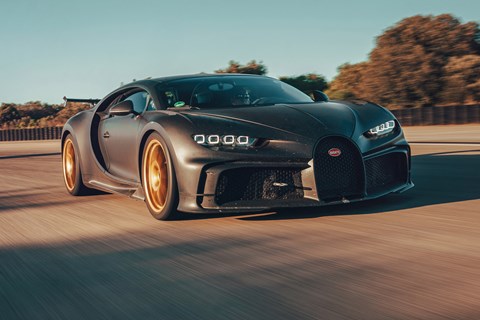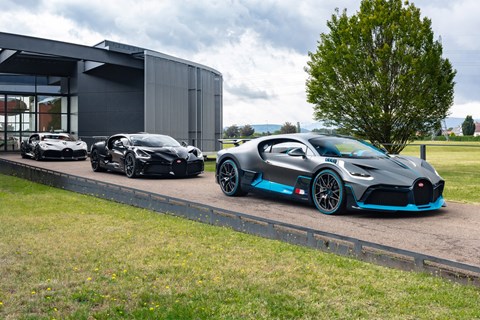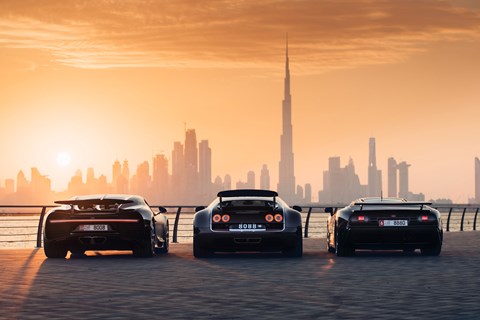► ‘Bugatti Rimac’ joint venture details
► Rimac has 55 per cent share, Porsche has 45
► CAR scooped first details back in September 2020
Bugatti is to become part of a new joint venture between Rimac and Porsche.
The new joint venture, named ‘Bugatti Rimac’, means that Bugatti shares will be transferred out of the Volkswagen Group and into this new group automotive company.
CAR was the first to reveal exclusive details of these plans back in September 2020. Now official, the ‘Bugatti Rimac’ joint venture will be officially formed in the last quarter of 2021.
‘Porsche, Bugatti and Rimac are a perfect match,’ Porsche CEO Oliver Blume told CAR not long before the official announcement. ‘The Croatians are fast movers in terms of battery and software development, low-volume high-end products, prototyping, and forward thinking as far as the zero emission big picture is concerned.
‘The goal for Bugatti in this joint venture is to accelerate the essential engineering transformation and to carefully adapt and hone its key brand values. Last but not least, Porsche also has a vested interest in the outcome of this cooperation – after all, the 918 Spyder may one day get an even more advanced replacement,’ Blume added.
How will this new ‘Bugatti Rimac’ joint venture work?
Rimac holds 55 per cent of the share, with Porsche controlling the other 45 per cent. Under the new corporate structure Porsche effectively takes over all Bugatti responsibilities. The main assets of the Molsheim-based luxury car maker are its global sales and service network, the cult status of its second to none products and the iconic brand image.

Rimac’s prime strength, meanwhile, is best demonstrated by the C-One and Nevera hypercars, but what impressed the German delegation even more were the dramatically advanced batteries and the ultrafast software implanted in a couple of converted Porsche plug-in hybrid demonstrators.
Why is Bugatti changing hands?
Volkswagen Group no longer wants to lavish money and manpower on the so-called hobby brands acquired by the former CEO. Instead, all resources must be devoted to fund the massive investment programme in the future of motoring – electrification, digitalisation and autonomous driving.
But how can VW sever ties with Bugatti without losing the support of the surviving Piech family members, which owns 50 per cent of the controlling interest in the group? The answer is simple: by putting their beloved Porsche at the heart of any deal and acting to the mutual benefit of all parties. Which they have done.
If the future of motoring is electric – not 1500bhp petrol-powered hypercars that sell in the hundreds – then getting their hooks further into Rimac, a company with a reputation for stellar EV tech, sounds very beneficial indeed.

This deal would have never happened under the late Ferdinand Piech, former boss of both VW’s managing board and then its supervisory chairman. After all, Bugatti was his master’s favourite toy in a collection to which the Austrian patriarch had added such prestigious brands as Bentley and Lamborghini during his reign. But Piech fell out with Volkswagen in 2015, and passed away four years later.
What benefits can we expect out of the venture?
It’s common knowledge that Porsche will start its progressive switch to EVs beyond the Taycan with its new Macan. On the sports car front, the Boxster and Cayman are to go plug-in in 2023 and 2024 respectively, with a twelve month grace period for the runout petrol variants. The next step for the evergreen 911 icon, is the 994 due in late 2023. In essence, this is an evolution of the 992, but it also will be the first of its kind to feature a bunch of bigger-displacement environment-friendly long-range PHEV powertrains.
As far as Porsche goes, the Rimac Nevera hypercar is expected to provide the genetic code for the 918 replacement which may be first shown in 2023 before going on sale two years later. The still nameless high-voltage effort compiled in Weissach and Sveta Nedelja effectively supersedes all previous supercar concepts.
Porsche’s real revolution will begin in 2028 with ‘Project 998’ – almost certainly a fully-fledged EV supercar promising over 100kWh in battery capacity, choices of two and four-wheel drive, 400-600 miles of e-range, two or three motors, torque blitz vectoring, virtually any kind of tyre-shredding power and torque combination you can dream up.

Where does this leave Bugatti and Rimac – the two named brands in the joint venture? With Porsche boss Blume being his latest and most ardent backer, Mate Rimac is contemplating taking his company public in 2022 – a move that should yield around €5bn. Although Stephan Winkelmann is still officially CEO of Bugatti, he must from now on presumably share the strings to be pulled with Mate Rimac and Blume. The board had briefly contemplated to move Bugatti under the Audi umbrella together with Bentley and Lamborghini, but then decided against it due to a near total lack of synergies.
Winkelmann has an all-electric CUV as second Bugatti model due to a lack of funds, and now Mate Rimac is quoted by German media as favouring a plug-in hybrid, not a thoroughbred EV, to take the brand into the post-Chiron era. While an odd choice from Rimac, a man who favours full-electric powertrains, the new kid on the block seems to think that after 112 years of combustion engines the marque should first celebrate the fusion of both worlds before embarking on a fully electric journey